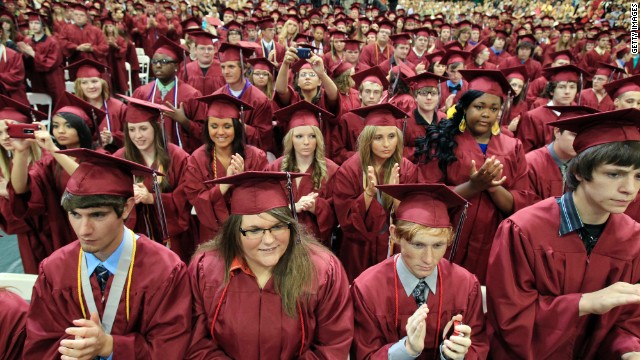- Back to Home »
- What you won't hear at graduation

- Authors say too many still fail to graduate high school
- Progress has been made in communities that tackled the issue head on, they say
- Authors: Today's economy requires more than a high school diploma
Editor's note: Editor's note: Robert Balfanz is director of the Everyone Graduates Center at Johns Hopkins University's School of Education and John Gomperts is president and CEO of America's Promise Alliance.
(CNN) -- Graduation season is in full swing, bringing with it a lot of discussion about life and opportunity. Inevitably there will be news stories about graduation ceremonies or a new YouTube video sensation focusing on commencement words of wisdom. While inspiring, those stories never give a full portrait of this rite of passage in America.
High school graduation—once the end of educational achievement for many—is now really just the starting line. The changing economy means that people who don't receive any post-secondary education will have access to only 40% of jobs in the next decade.
The beginning of this year's commencement season coincided with the 30th anniversary of one of the most important education reports the nation ever produced. "A Nation at Risk" warned that a mediocre education system put America's future in such serious jeopardy that had a foreign power imposed this poor performance on us, "we might well have viewed it as an act of war."


Yet three decades later, the reading and math skills of America's 15-year-olds still rank, respectively, as "average" and "below average" among developed nations. So, as you attend your next graduation ceremony, here are five things you won't hear but need to know.
• Not everyone eventually gets a diploma.
In reality, fewer than 80% of students receive a regular high school diploma (not simply a GED) within four years. That number drops to less than 70% for African-American students and lower yet for students with disabilities and English language learners.
A "real" diploma based on rigorous curriculum matters because the jobs of the future demand a workforce with skills aligned with a knowledge-based economy. For a nation that will become "majority minority" within a generation, we must work not only to increase the number of real diplomas, but also to see that all students receive one. The good news is that graduation rates are actually on the rise in the United States. As a result, the nation is on track for the first time to achieve a 90% national graduation rate by the class of 2020.
• We know where the challenges are the greatest and who needs our help the most.
Just 11% of America's high schools — the so-called "dropout factories" — account for half of the African-American and Latino students who fail to finish, and 40% of all students. At these schools, four-year graduation rates are 60% or lower.
 Helping Latinos stay in school
Helping Latinos stay in school Thanks to better data, we not only know which schools are unable to graduate their students, but also which students are struggling long before they even enter high school.
Targeting the neediest students, schools and neighborhoods is paying huge dividends. In 2002, there were 2,007 dropout factories in the United States. Today that number is 1,434. (A "dropout factory" is a high school with a graduation rate of 60% or less.) That means nearly 1.1 million fewer students are trapped in our lowest-performing high schools. It's no coincidence that as fewer students attended dropout factories, graduation rates began to climb.
• This is not just a challenge in urban areas and the South.
While the dropout crisis has been acute in these areas, low graduation rates are a widespread problem: rural, urban, East, West, North and South. Today the greatest improvement is occurring in the South and the cities. Graduation rate increases in the South, in fact, have outpaced those of other regions and these improvements have fueled the nation's overall progress.
Texas, Georgia and Florida, once the top three states for dropout factories, are now the top three in reducing the number of low-performing schools. Cities have seen tremendous progress as well, decreasing their number of dropout factories by 18%.
Double-digit gains in graduation rates in New York, the nation's largest public school system, demonstrate what can be done when the education of children becomes a civic priority.
• More challenging curriculum and better teachers are not enough.
This is probably the biggest misconception out there. Quality schools and teachers are essential, but they alone are not enough, especially in the highest poverty schools, where hundreds of students are chronically absent, missing a month or more of school, or have a home life that is less than ideal.
The best teachers and most thoughtful curriculum won't succeed if students are not in school regularly and don't have a supportive adult figure or safe place to go. Thus the five percentage point gain in graduation rates since 2006 didn't occur simply because all low-performing schools suddenly became better. What happened was a coordinated effort across the nation.
Integrated efforts to combine school redesign, accountability and quality with enhanced, better targeted and more evidence-based student supports began to spread more broadly So did awareness of the problem and the solutions, and all sectors in this country from policymakers to businesses began to support this work.
Entire communities began taking ownership of the issue in a hands-on way. This combination has been a recipe for real progress.
One example of this approach at work is Shelbyville Senior High School in Shelbyville, Indiana. In 2006, the school's poor performance—where one in three students did not graduate—was featured on the cover of TIME magazine.
Six years later, the school is in a much different place, with nine in 10 students earning a diploma.
Shelbyville's progress is a result of a coordinated approach between the school and community, in which graduation became the priority for everyone. The school's culture reflected this, changing to a positive one that nurtured students and expected success from all. The district instituted an early warning system that collects and monitors data on each student so those at risk can be supported from the moment challenges arise.
Shelbyville also created alternative learning environments for students not succeeding in traditional high school and teachers, counselors and school leadership now meet regularly to discuss what's working and isn't.
• Education isn't just a local issue. What happens at the school a few communities away affects you.
We all pay a heavy price when young people fail to graduate. The economic consequences of failing to graduate— lower incomes, less spending power, higher costs for public assistance programs, higher rates of incarceration — are comparable to the effects of a permanent national recession.
Many businesses report they have trouble finding enough qualified candidates for the jobs they have, which affects both our economic growth and our nation's ability to compete in a global economy. Because the military cannot accept candidates who lack a high school diploma, the dropout crisis even has national security implications.
Until we achieve at least a 90% national graduation rate, and see that students leave high school equipped for success in college and career, we will not be simply a collection of communities at risk, we will remain a nation at risk.
Follow us on Twitter @CNNOpinion .
Join us on Facebook/CNNOpinion .
The opinions expressed in this commentary are solely those of the authors.







